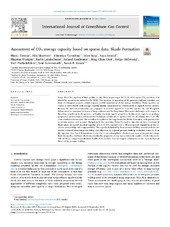| dc.contributor.author | Elenius, Maria | |
| dc.contributor.author | Skurtveit, Elin | |
| dc.contributor.author | Yarushina, Viktoriya M. | |
| dc.contributor.author | Baig, Irfan | |
| dc.contributor.author | Sundal, Anja | |
| dc.contributor.author | Wangen, Magnus | |
| dc.contributor.author | Landschulze, Karin | |
| dc.contributor.author | Kaufmann, Roland | |
| dc.contributor.author | Choi, Jung Chan | |
| dc.contributor.author | Hellevang, Helge | |
| dc.contributor.author | Podladchikov, Yuri | |
| dc.contributor.author | Aavatsmark, Ivar | |
| dc.contributor.author | Gasda, Sarah | |
| dc.date.accessioned | 2019-03-20T17:42:16Z | |
| dc.date.available | 2019-03-20T17:42:16Z | |
| dc.date.issued | 2018-12 | |
| dc.Published | Elenius M, Skurtveit E, Yarushina VM, Baig I, Sundal A, Wangen M, Landschulze K, Kaufmann R, Choi JC, Hellevang H, Podladchikov Y, Aavatsmark IA, Gasda SE. Assessment of CO2 storage capacity based on sparse data: Skade Formation. International Journal of Greenhouse Gas Control. 2018;79:252-271 | eng |
| dc.identifier.issn | 1750-5836 | en_US |
| dc.identifier.issn | 1878-0148 | en_US |
| dc.identifier.uri | https://hdl.handle.net/1956/19230 | |
| dc.description.abstract | Large North Sea aquifers of high quality are the likely major target for 12 Gt of European CO2 emissions that should be stored in the subsurface by 2050. This involves an upscaling of the present combined injection rate from all European projects, which requires careful examination of the storage feasibility. Many aquifers are closed or semi-closed, with storage capacity mainly constrained by consideration of caprock failure criteria. Because the induced overpressure can propagate to sensitive regions far from the injector, the risk of caprock failure must be examined in terms of large volumes and for long times. This poses challenges with respect to fluid-flow simulation in the presence of highly uncertain aquifer properties. In this work, experts on geology, geophysics, geomechanics and simulation technique collaborate to optimize the use of existing data in an efficient simulation framework. The workflow is applied to the large North Sea Skade Formation, with potential for secondary storage and pressure dissipation in the overlying Utsira Formation. Injection at three locations in Skade gives an overall practical capacity of 1–6 Gt CO2 injected over a 50-year period, depending on the reservoir permeability and compressibility. The capacity is limited by local pressure buildup around wells for the lowest estimated reservoir permeability, and otherwise by regional pressure buildup in shallow zones far from the injection sites. Local deformation of clay due to viscoelastoplastic effects do not have an impact on leakage from the aquifer, but these effects may modify the properties of clay layers within the aquifer, which reduces the risk of lateral compartmentalization. Uplift of the seafloor does not impose constraints on the capacity beyond those set by pressure buildup. | en_US |
| dc.language.iso | eng | eng |
| dc.publisher | Elsevier | en_US |
| dc.rights | Attribution CC BY | eng |
| dc.rights.uri | http://creativecommons.org/licenses/by/4.0/ | eng |
| dc.subject | Geological CO2 storage | eng |
| dc.subject | Dynamic capacity estimation | eng |
| dc.subject | Skade Formation | eng |
| dc.subject | Utsira Formation | eng |
| dc.subject | Geological characterization | eng |
| dc.subject | Basin-scale simulation | eng |
| dc.subject | Norwegian continental shelf | eng |
| dc.title | Assessment of CO2 storage capacity based on sparse data: Skade Formation | en_US |
| dc.type | Peer reviewed | |
| dc.type | Journal article | |
| dc.date.updated | 2018-11-20T15:13:45Z | |
| dc.description.version | publishedVersion | en_US |
| dc.rights.holder | Copyright 2018 The Authors | en_US |
| dc.identifier.doi | https://doi.org/10.1016/j.ijggc.2018.09.004 | |
| dc.identifier.cristin | 1632834 | |
| dc.source.journal | International Journal of Greenhouse Gas Control | |
| dc.relation.project | Norges forskningsråd: 193825 | |

